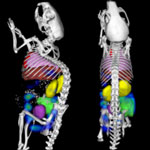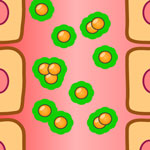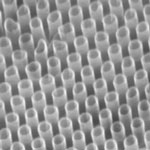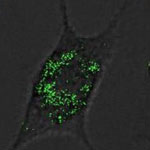Showing Spotlights 289 - 296 of 556 in category All (newest first):
 The subventricular zone (SVZ) is a region in the mammalian brain where self-renewing and multipotent neural stem cells give rise to new brain cells such as neurons, astrocytes, and oligodendrocytes. Neuroscientists and cell biologists are keen to use nanotechnologies to manipulate endogenous stem cell niches such as the SVZ. New work describes the first example in the manipulation of the neural stem cell niche by the use of nanoparticles releasing a pro-neurogenic agent - retinoic acid.
The subventricular zone (SVZ) is a region in the mammalian brain where self-renewing and multipotent neural stem cells give rise to new brain cells such as neurons, astrocytes, and oligodendrocytes. Neuroscientists and cell biologists are keen to use nanotechnologies to manipulate endogenous stem cell niches such as the SVZ. New work describes the first example in the manipulation of the neural stem cell niche by the use of nanoparticles releasing a pro-neurogenic agent - retinoic acid.
Dec 6th, 2012
 One of the key issues in the development of novel nanomedicines is the ability to track nanoscale drug carriers inside the body to evaluate where they go and how they get there. Virtually all previous preclinical studies in this area of research rely on 2D Fluorescence Reflectance Imaging (FRI). Given the limitation of 2D FRI in not being able to detect the fluorescence in deep-seated organs and tissues, 3D Fluorescence Molecular Tomography (3D FMT) emerged as an alternative. However, the lack of anatomical information was an important barrier hindering the routine use of standard 3D FMT for in vivo imaging of nanomedicines. Researchers have now developed a hybrid CT-FMT-based imaging protocol to enable more meaningful and more quantitative in vivo analyses.
One of the key issues in the development of novel nanomedicines is the ability to track nanoscale drug carriers inside the body to evaluate where they go and how they get there. Virtually all previous preclinical studies in this area of research rely on 2D Fluorescence Reflectance Imaging (FRI). Given the limitation of 2D FRI in not being able to detect the fluorescence in deep-seated organs and tissues, 3D Fluorescence Molecular Tomography (3D FMT) emerged as an alternative. However, the lack of anatomical information was an important barrier hindering the routine use of standard 3D FMT for in vivo imaging of nanomedicines. Researchers have now developed a hybrid CT-FMT-based imaging protocol to enable more meaningful and more quantitative in vivo analyses.
Nov 13th, 2012
 When a nanomaterial enters a biological environment, it comes into contact with a complex mixture of proteins. Some of these proteins can adhere to the surface of the nanomaterial, forming a protein 'corona' that influences its subsequent biological interactions. While a number of studies have characterized the protein corona formed around nanomaterials with diameters greater than 10nm, until now, lack of a suitable separation technique has prevented researchers from studying the protein corona formed around 'ultrasmall' nanomaterials. A team of European researchers used electrophoresis to separate ultrasmall nanomaterials from free protein. Applying this technique, they discovered that ultrasmall nanomaterials interact with proteins in a way that is fundamentally different from larger nanomaterials with analogous composition.
When a nanomaterial enters a biological environment, it comes into contact with a complex mixture of proteins. Some of these proteins can adhere to the surface of the nanomaterial, forming a protein 'corona' that influences its subsequent biological interactions. While a number of studies have characterized the protein corona formed around nanomaterials with diameters greater than 10nm, until now, lack of a suitable separation technique has prevented researchers from studying the protein corona formed around 'ultrasmall' nanomaterials. A team of European researchers used electrophoresis to separate ultrasmall nanomaterials from free protein. Applying this technique, they discovered that ultrasmall nanomaterials interact with proteins in a way that is fundamentally different from larger nanomaterials with analogous composition.
Nov 2nd, 2012
 The ideal drug carrier may be something out of science fiction. In principle, it is injected into the body and transports itself to the correct target, such as a tumor, and delivers the required dose at this target. This idealized concept was first proposed by Paul Ehrlich at the beginning of the 20th century and was nicknamed the 'magic bullet' concept. With the advent of nanotechnology and nanomedicine this dream is rapidly becoming a reality. Researchers have already demonstrated that unctionalized carbon nanotubes (CNTs) might be able to target specific cells, become ingested, and then release their contents in response to a chemical trigger. A group of researchers has now essentially achieved this goal. They have encapsulated drugs inside carbon nanotubes for drug delivery and shown that these drugs can be released 'on command' by inductive heating with an external alternating current or pulsed magnetic field.
The ideal drug carrier may be something out of science fiction. In principle, it is injected into the body and transports itself to the correct target, such as a tumor, and delivers the required dose at this target. This idealized concept was first proposed by Paul Ehrlich at the beginning of the 20th century and was nicknamed the 'magic bullet' concept. With the advent of nanotechnology and nanomedicine this dream is rapidly becoming a reality. Researchers have already demonstrated that unctionalized carbon nanotubes (CNTs) might be able to target specific cells, become ingested, and then release their contents in response to a chemical trigger. A group of researchers has now essentially achieved this goal. They have encapsulated drugs inside carbon nanotubes for drug delivery and shown that these drugs can be released 'on command' by inductive heating with an external alternating current or pulsed magnetic field.
Oct 30th, 2012
 The heating properties of iron oxide nanoparticles have been exploited through the years for use in cancer therapy, gene regulation, and temperature responsive valves. These applications have demonstrated the versatility of iron oxide nanoparticles, but they had rarely, if ever, been used to enhance the activity of thermophilic enzymes. Thermophilic enzymes are highly stable biomolecular systems that are excellent tools due to their thermostability and long-term activity for extended lifetime uses in the field and other applications. New work by researchers in the U.S. addresses the problem of remotely activating biological materials with a higher efficiency than conventional methods such as water baths or convection ovens.
The heating properties of iron oxide nanoparticles have been exploited through the years for use in cancer therapy, gene regulation, and temperature responsive valves. These applications have demonstrated the versatility of iron oxide nanoparticles, but they had rarely, if ever, been used to enhance the activity of thermophilic enzymes. Thermophilic enzymes are highly stable biomolecular systems that are excellent tools due to their thermostability and long-term activity for extended lifetime uses in the field and other applications. New work by researchers in the U.S. addresses the problem of remotely activating biological materials with a higher efficiency than conventional methods such as water baths or convection ovens.
Oct 15th, 2012
 Silver nanoparticles are among the most commercialized nanomaterials due to their use as antibacterial agent in consumer products and surface coatings. Several reports have shown that silver ions from silver compounds or those that develop from nanosilver particles through contact with water are highly toxic to microorganisms such as bacteria, fungi and algae. Contributing to an incomplete and confusing picture, in the literature, silver nanoparticles are claimed as nontoxic or toxic depending on their size, concentration and surface functionalization. Researchers have now reported on possible adverse effects of the silver nanoparticles upon their release into the environment and provided novel insights into the possible applications of silver nanoparticles in nanomedicine by discussing their p53 gene related cell death profiles.
Silver nanoparticles are among the most commercialized nanomaterials due to their use as antibacterial agent in consumer products and surface coatings. Several reports have shown that silver ions from silver compounds or those that develop from nanosilver particles through contact with water are highly toxic to microorganisms such as bacteria, fungi and algae. Contributing to an incomplete and confusing picture, in the literature, silver nanoparticles are claimed as nontoxic or toxic depending on their size, concentration and surface functionalization. Researchers have now reported on possible adverse effects of the silver nanoparticles upon their release into the environment and provided novel insights into the possible applications of silver nanoparticles in nanomedicine by discussing their p53 gene related cell death profiles.
Sep 12th, 2012
 Nanotechnology is gaining significant interest in plant sciences with research focusing on investigating plant genomics and gene function as well as improving crop species. The impact on agriculture could be dramatic. Most of the work done with nanoparticles in plant sciences relies on a passive uptake of nanoparticles by plant cells - a process that cannot be controlled. Plant cells differ from animal cells in several aspects, a major one being that they possess a wall surrounding them to provide, among other things, mechanical and structural support. Researchers are commonly using surface-functionalized silica nanoparticles as nonviral nanocarriers for experimental drug and DNA delivery into animal cells but their use with plants so far was limited due to the barriers posed by the cell wall. Following up on previous work, researchers have made this process more efficient and introduced a much more challenging biomolecule to plant cells - proteins.
Nanotechnology is gaining significant interest in plant sciences with research focusing on investigating plant genomics and gene function as well as improving crop species. The impact on agriculture could be dramatic. Most of the work done with nanoparticles in plant sciences relies on a passive uptake of nanoparticles by plant cells - a process that cannot be controlled. Plant cells differ from animal cells in several aspects, a major one being that they possess a wall surrounding them to provide, among other things, mechanical and structural support. Researchers are commonly using surface-functionalized silica nanoparticles as nonviral nanocarriers for experimental drug and DNA delivery into animal cells but their use with plants so far was limited due to the barriers posed by the cell wall. Following up on previous work, researchers have made this process more efficient and introduced a much more challenging biomolecule to plant cells - proteins.
Sep 10th, 2012
 Thanks to nanotechnologies, in particular nanoelectronics, the medical sector is about to undergo deep changes by exploiting the traditional strengths of the semiconductor industry - miniaturization and integration. While conventional electronics have already found many applications in biomedicine - medical monitoring of vital signals, biophysical studies of excitable tissues, implantable electrodes for brain stimulation, pacemakers, and limb stimulation - the use of nanomaterials and nanoscale applications will bring a further push towards implanted electronics in the human body. A new perspective article provides an overview of nanoelectronics' potential in the biomedical sciences.
Thanks to nanotechnologies, in particular nanoelectronics, the medical sector is about to undergo deep changes by exploiting the traditional strengths of the semiconductor industry - miniaturization and integration. While conventional electronics have already found many applications in biomedicine - medical monitoring of vital signals, biophysical studies of excitable tissues, implantable electrodes for brain stimulation, pacemakers, and limb stimulation - the use of nanomaterials and nanoscale applications will bring a further push towards implanted electronics in the human body. A new perspective article provides an overview of nanoelectronics' potential in the biomedical sciences.
Aug 16th, 2012
 The subventricular zone (SVZ) is a region in the mammalian brain where self-renewing and multipotent neural stem cells give rise to new brain cells such as neurons, astrocytes, and oligodendrocytes. Neuroscientists and cell biologists are keen to use nanotechnologies to manipulate endogenous stem cell niches such as the SVZ. New work describes the first example in the manipulation of the neural stem cell niche by the use of nanoparticles releasing a pro-neurogenic agent - retinoic acid.
The subventricular zone (SVZ) is a region in the mammalian brain where self-renewing and multipotent neural stem cells give rise to new brain cells such as neurons, astrocytes, and oligodendrocytes. Neuroscientists and cell biologists are keen to use nanotechnologies to manipulate endogenous stem cell niches such as the SVZ. New work describes the first example in the manipulation of the neural stem cell niche by the use of nanoparticles releasing a pro-neurogenic agent - retinoic acid.
 Subscribe to our Nanotechnology Spotlight feed
Subscribe to our Nanotechnology Spotlight feed





